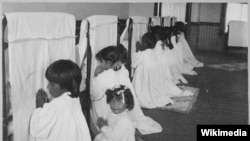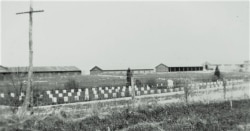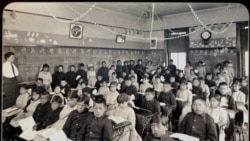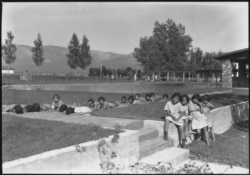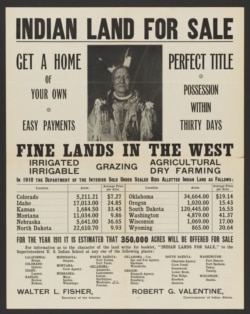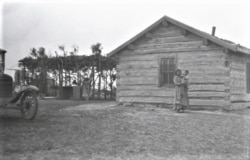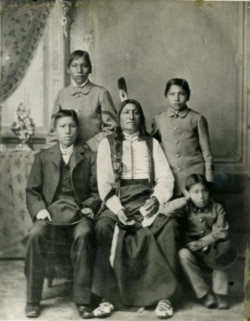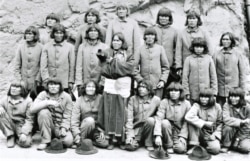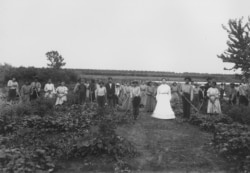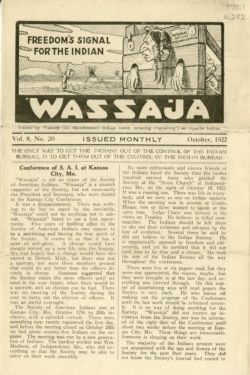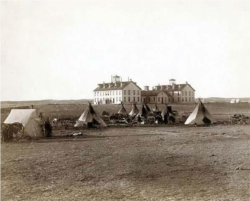Ask most Native Americans about Indian boarding schools, and they will tell you that from 1879 through the late 1970s, the federal government forcibly removed thousands of Native children from their families and placed them in remote, military-style boarding schools. There, the children were abused, stripped of language and culture, and in some cases died under mysterious circumstances and were buried in unmarked graves.
In announcing a federal investigation into the boarding schools, U.S. Interior Secretary Deb Haaland recently said, “The legacy of Indian boarding schools remains, manifesting itself in Indigenous communities through intergenerational trauma, cycles of violence and abuse, disappearance, premature deaths, and other undocumented bodily and mental impacts.” Haaland is the first Native American to serve in the U.S. Cabinet.
But some Native historians worry that narrative is one-dimensional.
In her book, “Boarding School Seasons,” Brenda J. Child, a citizen of the Red Lake band of Chippewa and the Northrop professor of American studies at the University of Minnesota, notes the actual history of government boarding schools differs from the historical memory of the current generation.
“History is enormously complicated, and we sometimes want easier explanations for the past,” she told VOA.
Child believes many Native Americans blame boarding schools for everything bad that ever happened to them under colonialism.
“The narrative doesn’t reflect the complexities and contradictions of the boarding school system, which was different for each generation,” she said.
Hard decisions
Amanda Takes War Bonnet, an Oglala Lakota journalist from the Pine Ridge Indian Reservation and a former managing editor of Indian Country Today, now works at the Native Women's Society of the Great Plains, an organization dedicated to stopping violence against women.
She tells the story of her grandmother, Helen Cottier, who in September 1930 received word that her 13-year-old son Albert -- Take War Bonnet’s uncle -- had died after only a year away at the Indian Industrial School in Genoa, Nebraska.
“My grandmother had to travel by buckboard wagon to Merriman, Nebraska, to fetch her son’s body at the train depot,” Takes War Bonnet said. “My mother, Rebecca, was a little girl then. She wrote in her diary that she was excited that her brother was coming home. Only she didn’t know he would be coming home in a box.”
Helen’s marriage did not survive the grief of losing a child. Her husband abandoned her. Shortly afterward, she sent her surviving children to another boarding school, this time located about 70 kilometers away -- a decision that might be baffling to some.
A closer look at that era in U.S. history offers insight into her decision.
Traditionally, Native Americans lived communally and could rely on one another for support during hard times. That changed after 1887 when the U.S. government carved up reservations into small allotments and parceled them out to individuals and families registered on federal rolls.
The government then sold off the remaining land -- about 40.5 million hectares -- mostly to non-Natives. The result was that reservations ended up in a “checkerboard” of ownership that left tribes divided and families torn apart.
In 1928, the government commissioned a study of conditions on Indian reservations. The so-called “Meriam Report” concluded that reservation Indians had not assimilated into the “dominant economic and social system” and were living in a state of extreme poverty on mostly unfarmable land.
After the stock market crash of 1929, the nation plunged into the Great Depression, and no one suffered more than the Indians of South Dakota, according to a 1935 study by the South Dakota Emergency Relief Administration. Case workers described families living in “wretched” and “demoralizing” conditions, subsisting on inadequate rations and vulnerable to tuberculosis and other infectious diseases.
In 1930, facing the prospect of rearing four children by herself, Cottier likely saw the boarding school as a place where her children were at least guaranteed food, clothing and a warm bed.
According to Child, the 1930s became the period with the highest enrollment in Indian boarding schools.
A look at the facts
The federal government, contrary to common belief, operated only 25 off-reservation boarding schools as part of its effort to assimilate Native youth into American culture. The remaining boarding schools — roughly 340 — were located on reservations and run by religious groups on land provided by the government.
Originally, attendance in government boarding schools was voluntary. Forced attendance wouldn’t come until more than a decade after the first federal boarding school — the Carlisle Indian Industrial School — was founded in 1879.
In his memoir “Battlefield and Classroom,” Carlisle founder Richard Henry Pratt described his visit to the Rosebud Indian Reservation in South Dakota, where he hoped to recruit students.
At first, Brulé Lakota Chief Spotted Tail was unimpressed by the idea.
“The white people are all thieves and liars,” he told Pratt, pointing to the federal government’s seizure of the Black Hills. “We do not want our children to learn such things.”
In the end, the chief relented and sent his four sons, daughter and her husband, a Lakota interpreter of mixed blood, to Pennsylvania. But when Spotted Tail visited Carlisle the following year and saw his sons dressed and drilled like soldiers, he became angry and took them out of school.
In 1891, the government authorized reservation agents to withhold benefits from families who refused to send their children to school; some agents resorted to force, abducting children from their homes at gunpoint.
Many parents hid their children or found other ways to resist federal authorities. In 1894, for example, 19 Hopi “hostiles” refused to give up their children and were imprisoned for a year on Alcatraz Island off the coast of California.
K. Tsianina Lomawaima, a retired Arizona State University professor of Native American studies and unenrolled Muscogee Indian, interviewed dozens of former students at the Chilocco Indian School in Oklahoma for her book, “They Called It Prairie Light.”
“My dad was at Chilocco from 1927 -- when he was about 8, 9 years old -- until he ran away in 1935,” she told VOA.
She contradicts the notion of boarding school students as submissive victims, describing the creative ways students rebelled against authoritarianism.
“The boys organized themselves into gangs, and they got into mischief,” she said. “It ran the gamut from sneaking out at night to ride the draft horses to setting fires to distilling home whiskey.”
The boarding school curriculum may have been designed to “kill the Indian” in students. But that didn’t stop them from speaking their languages or covertly practicing their traditions.
Lomawaima said that Chilocco students held “stomp dances” around bonfires, sang tribal songs and beat gourd drums; she relates one instance in which Ponca students used peyote in a dormitory ceremony.
Seeds of activism
In 1913, Carlisle students petitioned Washington, complaining about unfair discipline, poor food and sanitation, and financial mismanagement under the school’s third superintendent, Moses Friedman. This resulted in a joint congressional hearing, where lawmakers heard testimony from teachers and students. Eventually, the government removed Friedman from his post.
Sometimes boarding school grievances overflowed into violence: In her book, Minnesota professor Child describes a 1919 incident at the Haskell Institute in Lawrence, Kansas, in which students cut off the school’s electricity and staged a riot, looting food and destroying school property.
Historians have noted that the intermingling of youths from many different tribes in boarding schools helped pave the way for early intertribal activist movements, such as the Society of American Indians and the Brotherhood of North American Indians, both of which organized in 1911, and later, the League of North American Indians, established in 1935.
Mixed legacy
Today, Native Americans offer conflicting narratives about their families’ boarding school experiences. Most agree that the schools all but destroyed family and tribal ties.
“My mother spent 11 years at school, so she never was able to connect with her mother, brothers and sisters,” said Takes War Bonnet. “So, after she married, she had a hard time parenting us.”
Some parents took advantage of the system, according to Lakota journalist James Giago Davies. His mother attended the Holy Rosary Mission Boarding School in Pine Ridge, where children could go home at Christmas and during the summer.
“My mom said a surprising number of parents just left their kids at school over Christmas,” he said. “And this still exists on reservations today. Schools become refuge for children because their home environment is dysfunctional, or their families can’t support them.”
Davies notes one positive impact of the boarding school era.
“We knew exactly how the Indian world worked and now we knew exactly how the white world worked. So, we were savvy to both,” he said.
Today, Native Americans are hoping the federal government will be able to account for ancestors who never returned from boarding schools. They are also pushing for a truth and reconciliation process to help them heal from boarding school trauma that still lingers.
Retired professor Lomawaima said she hopes that in so doing, they won’t “throw the baby out with the bathwater.” It’s a common American idiom for losing something important while trying to get rid of something unwanted.
“If you do that, you lose all the rich reality of folks who survived or even thrived,” she said.




